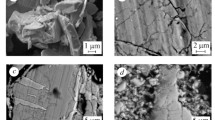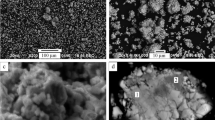We present a survey of the results of application of various modes of hydrogen treatment of ferromagnetic materials based on the SmCo5 compound aimed at the formation of anisotropic nanostructures, namely, of mechanochemical milling, thermal treatment [hydrogenation, disproportionation, desorption, and recombination (HDDR)] of alloys in hydrogen, and the combination of milling in hydrogen with HDDR. It is shown that HDDR enables us to get alloys containing the SmCo5, Sm2Co17, and Sm2Co7 phases with grain sizes within the range 60–100 nm and the single-phase magnetic behavior. The anisotropic powders with microstructural grain sizes within the range 40–75 nm and coercive forces higher than 40 kOe were obtained after milling in hydrogen combined with HDDR. A combined method of processing including the procedure of milling of the alloys in hydrogen and HDDR treatment is proposed for the formation of the microstructure of ferromagnetic alloys with high dispersion and high magnetic properties. It is experimentally demonstrated that the formation of anisotropy in ferromagnetic alloys by disproportionation and recombination is possible if the residual amounts of the main phase of the alloy remain in the metal after disproportionation.









Similar content being viewed by others
References
K. J. Strnat and R. M. W. Strnat, “Rare earth-cobalt permanent magnets,” J. Magn. Magn. Mater., 100, 38–56 (1991).
R. Coehoorn, D. B. de Mooij, and C. de Waard, “Melt-spun permanent magnet materials containing Fe3B as the main phase,” J. Magn. Magn. Mater., 80, 101–104 (1989).
E. F. Kneller and R. Hawig, “The exchange-spring magnet: A new material principle for permanent magnets,” IEEE Trans. Magn., 27, 3588–3600 (1991).
J. Ping Liu, E. Fullerton, O. Gutfleisch, and D. J. Sellmyer (editors), Nanoscale Magnetic Materials and Applications, Springer, New York (2009).
R. Manaf, R. A. Buckley, and H. A. Davis, “New nanocrystalline high-remanence Nd–Fe–B alloys by rapid solidification,” J. Magn. Magn. Mater., 128, 302–306 (1993).
L. Withanawasam, G. C. Hadjipanayis, and R. F. Krause, “Enhanced remanence in isotropic Fe-rich melt-spun Nd–Fe–B ribbons,” J. Appl. Phys., 75, 6646–6648 (1994).
J. Ding, P. G. McCormick, and R. Street, “Remanence enhancement in mechanically alloyed isotropic Sm7Fe93-nitride,” J. Magn. Magn. Mater., 124 1–4 (1993).
O. Donnell, C. Kuhrt, and J. M. D. Coey, “Influence of nitrogen content on coercivity in remanence-enhanced mechanically alloyed Sm– Fe–N,” J. Appl. Phys., 76, 7068–7070 (1994).
D. Lee, S. Bauser, A. Higgins, et al., “Bulk anisotropic composite rare earth magnets,” J. Appl. Phys., 99, 08B516-1–108B516-3 (2006).
G. C. Hadjipanayis and A. M. Gabay, “Overview of the high-temperature 2:17 magnets,” in: HPMA’04, 18th Internat. Workshop on High Performance Magnets and Their Applications, Annecy (France) August 29–September 2 (2004) (on CD).
G. C. Hadjipanayis, J. Liu, A. M. Gabay, and M. Marinesku, “Current status of rare-earth permanent magnet research in USA,” in: Proc. of the 19th Internat. Workshop on High Performance Magnets and Their Applications (Beijing China) 30.08–01.09.2006) (2006), pp. 12–22.
A. M. Gabay, W. F., Li, and G. C. Hadjipanayis, “Effect of hot deformation on texture and magnetic properties of Sm–Co and Pr– Co alloy,” J. Magn. Magn. Mater., 323, 2470–2473 (2011).
N. Cannesan and I. R. Harris, “Aspects of NdFeB HDDR powders: fundamentals and processing,” in: G. C. Hadjipanayis (editor), Bonded Magnets, NATO Science Series: II. Mathematics, Physics, and Chemistry, Kluwer, Dordrecht (2002), pp. 13–36.
Y. Honkura, “HDDR magnets and their potential use for automotive applications,” in: Proc. 18th Internat. Workshop on High Performance Magnets and Their Applications, Annecy (France), 2004, pp. 559–565 (on CD).
O. Gutfleisch, M. Matzinger, J. Fidler, and I. R. Harris, “Characterization of solid-HDDR processed Nd16Fe76B8 alloys by means of electron microscopy,” J. Magn. Magn. Mater., 147, 320–330 (1995).
I. I. Bulyk, Yu. B. Basaraba, A. M. Trostyanchyn, and V. M. Davydov, “Disproportionation in hydrogen and recombination of the Laves phases of zirconium with chromium,” Mater. Sci., 41, No. 3, 395–405 (2005).
M. Kubis, A. Handstein, B. Gebel, et al., “Highly coercive SmCo5 magnets prepared by a modified hydrogenation-disproportionation-desorption-recombination process,” J. Appl. Phys., 85, 5666–5668 (1999).
O. Gutfleisch, M. Kubis, A. Handstein et al., “Hydrogenation disproportionation desorption recombination in Sm–Co alloys by means of reactive milling,” Appl. Phys. Lett., 73, 3001–3003 (1998).
A. Handstein, M. Kubis, O. Gutfleisch et al., “HDDR of Sm–Co alloys using high hydrogen pressures,” J. Magn. Magn. Mater., 192, 73–76 (1999).
I. I. Bulyk, V. V. Panasyuk, and A. M. Trostianchyn, “Features of the HDDR process in alloys based on the SmCo5 compound,” J. Alloys Comp., 379, 154–160 (2004).
I. I. Bulyk and A. M. Trostyanchyn, “Structure of an alloy based on SmCo5 after disproportionation-recombination,” Mater. Sci., 42, No. 5, 644–648 (2006).
I. I. Bulyk and A. M. Trostyanchyn, “Hydrogenation-disproportionation in samarium-cobalt ferromagnetic alloys based on Sm2(Co,Fe,Cu, Zr)17,” Mater. Sci., 39, No. 4, 395–405 (2003).
S. Tao, J. Tian, X. Lu, et al., “Anisotropic bonded NdFeB magnets with radial oriented magnetization by 2-step warm compaction process,” J. Alloys Comp., 477, 510–514 (2009).
I. I. Bulyk, A. M. Trostianchyn, V. G. Synyushko, et al., “Phase transformations in LaNi5−x Co x –H2 system,” Intermetallics, 13, 1220–1224 (2005).
I. I. Bulyk, V. V. Panasyuk, and A. M. Trostyanchyn, Procedure of Formation of Anisotropic Fine-Grained Structures of the Powders of Alloys of the Sm–Co System by Their Hydrogen-Vacuum Thermal Treatment [in Ukrainian], Patent 96,810 (Ukraine). H 01 F 1/053; H 01 F 1/055; B 82 B 3/00, Publ. on 12.12.2011, Bull. No. 23.
I. I. Bulyk, V. V. Panasyuk, and A. M. Trostyanchyn, Procedure of Formation of Anisotropic Fine-Grained Structures of the Powders of Alloys of the Sm–Co System by Their Milling in Hydrogen [in Ukrainian], Patent 96,811 (Ukraine). H 01 F 1/053; H 01 F 1/055; B 82 B 3/00, Publ. on 12.12.2011, Bull. No. 23.
I. I. Bulyk, Yu. B. Basaraba, and V. I. Markovych, “Production of functional nanocrystalline materials in hydrogen,” Mater. Sci., 39, No. 6, 841–848 (2003).
I. I. Bulyk, R. V. Denys, V. V. Panasyuk, Yu. H. Putilov, and A. M. Trostyanchyn, “HDDR process and the hydrogen-absorption properties of the didymium-aluminum-iron-boron (Dd12.3Al1.2Fe79.4B6) alloy,” Mater. Sci., 37, No. 4, 544–550 (2001).
L. G. Akselrud, Yu. N. Grin, and P. Yu. Zavalij, “CSD-universal program package for single crystal or powder structure data treatment,” in: Collected Abstr. of the 12th Europ. Crystallographic Meeting (Moscow, 20–29.08.1989) [in Russian], Vol. 3, Nauka, Moscow (1989), p. 155.
V. K. Pecharskii, L. G. Akselrud, and P. Yu. Zavalij, “On the method of taking into account the influence of predominant orientation (texture) in powder specimens for the investigation of the atomic structures of substances,” Kristallografiya, No. 4, 874–877 (1987).
I. I. Bulyk, A. M. Trostyanchyn, and V. I. Markovych, “Hydrogen-induced phase transformations in alloys based on SmCo5 under pressures of up to 650 kPa,” Mater. Sci., 43, No. 1, 102–108 (2007).
Author information
Authors and Affiliations
Corresponding author
Additional information
Translated from Fizyko-Khimichna Mekhanika Materialiv, Vol.48, No.1, pp.9–18, January–February, 2012.
Rights and permissions
About this article
Cite this article
Bulyk, I.I., Panasyuk, V.V. Hydrogen as a technological medium for the formation of nanostructures in Sm–Co ferromagnetic alloys. Mater Sci 48, 1–11 (2012). https://doi.org/10.1007/s11003-012-9466-1
Received:
Published:
Issue Date:
DOI: https://doi.org/10.1007/s11003-012-9466-1




